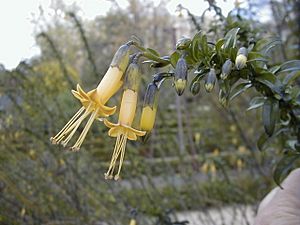Vestia foetida facts for kids
Quick facts for kids Vestia foetida |
|
|---|---|
 |
|
| Scientific classification | |
| Genus: |
Vestia (plant)
|
| Species: |
foetida
|
Vestia is a special type of plant group, or genus, because it has only one species in it: Vestia foetida. This is known as a monotypic genus. This plant is a member of the Solanaceae family, which is also known as the nightshade family.
In its home country of Chile, people have several names for it in their native Mapudungun language, such as Huevil (pronounced "way-fil") and Chuplín. A more recent English name for it is the Chilean box thorn.
Vestia foetida is endemic to central and southern Chile. This means it only grows naturally in that part of the world. It's an evergreen shrub that can grow up to 2 m (7 ft) tall and 1.5 m (5 ft) wide. It has shiny, mid-green leaves that look a bit like privet leaves.
In the spring and summer, it grows bright yellow, tube-shaped flowers that are about 3 cm (1 in) long. The flower's stamens stick out a lot, making them look similar to the flowers of a Fuchsia. After the flowers, the plant produces small, egg-shaped fruits that contain tiny seeds.
The second part of its scientific name, foetida, is Latin for "stinky." This is because the plant has an unpleasant smell!
Contents
Naming and Discovery
The genus Vestia was named in 1809 by the German botanist Carl Ludwig Willdenow. He named it to honor Lorenz Chrysanth von Vest, an Austrian botanist and doctor.
The species Vestia foetida was officially described in 1824 by Johann Centurius Hoffmannsegg in a book about plants grown in his gardens in Germany.
How People Have Used It
Traditional Medicine
For a long time, people in Chile have used Vestia foetida in their traditional medicine. They knew the plant was toxic, so they had to be careful. It was used to treat stomach problems like dysentery.
An expert on Chilean culture, Martin Gusinde, wrote about how the Mapuche and Huilliche people used the plant. They would add it to medicinal baths to help with serious fevers and other illnesses.
Another missionary, Ernest Wilhelm Mösbach, noted that the plant could make you sneeze and had a very bitter taste. He also wrote that it was used to make people feel stronger and to help with stomach aches.
People also used it in baths to help soothe the pain of arthritis.
Other Uses
A yellow dye can be made from the leaves and stems of the plant.
Is Vestia Foetida Poisonous?
Yes, it is. Like many plants in the nightshade family, Vestia contains poisonous chemicals called alkaloids.
Danger to Animals
The plant can be deadly to farm animals like sheep, goats, and cattle if they eat its leaves. The poison in the plant attacks and damages the animal's liver. This type of poisoning is very similar to that caused by a related plant called Cestrum parqui, which also grows in the same region.
Bug-Repelling Powers
Scientists have studied Vestia foetida to see if it can be used to fight insect pests. In one study, they tested extracts from the plant on the wheat weevil, a beetle that damages stored grain.
The results showed that the plant had some insect-killing ability. When the weevils were fed a diet containing 2.5% of the plant extract, 56% of them died within six days. While not as strong as some other plants tested, it shows that Vestia foetida has potential as a natural insecticide.
Growing the Plant
Even though it comes from a warmer climate, Vestia foetida can handle some frost. However, it needs to be planted in a spot that is sheltered from cold winter winds.
Because it's a beautiful and interesting plant, it has won the Royal Horticultural Society's Award of Garden Merit in the United Kingdom.
See also
 In Spanish: Huévil para niños
In Spanish: Huévil para niños


